The court

The basic principle is to keep hitting the ball against the front wall until your opponent cannot get it back any more.
The ball must hit the front wall above the board and below the out line.
The ball is only allowed to hit the floor once before each shot, but it can hit as many walls as the player wants.
If a player fails to hit the ball before it bounces twice, hits the ball into the floor before it hits the front wall, or hits it outside the out line, then they lose the rally.
A player can also lose a rally if the ball hits them or their clothing before they strike the ball.
Players must keep one foot in the service box as they serve.
The ball must hit the front wall between the service line and the out line, and land in the area behind the short line on the opposite side of the court.
A coin toss decides who serves at the start of a match.
Every rally a player wins they receive a point for.
The winner of the previous rally serves to start the next rally.
You can serve from either side initially but must alternate sides until you lose a rally (and therefore lose the serve).
First player to 11 points wins the game. First player to win 3 games (best of 5 games) wins the match.
Any comfortable sports wear is perfect for squash. You'll also need some clean trainers. Remember to bring some water as it is a great workout.
You'll need a squash racket and a squash ball, the bouncier the better as a beginner. You can just arrive at the squash without equipment as most clubs will let you borrow or hire the rackets and ball.
A rally
The serve
Scoring
What to wear
Equipment
Playing tips
1. HIGH SERVE!
A good serve can win you many points. Try to make the ball land near the back corners by using as much height on the front wall as possible. This forces your opponent to attempt to volley the ball. Volleying the ball (hitting the ball before it touches the floor) when it is very high is difficult for a beginner until you have played a few times.
2. FOUR CORNERS!
Always hit the ball so it lands near the corners or as close to the side walls as possible. This will drag your opponent away from the middle of the court (known as the ‘T’) so you can position yourself there.
3. IT IS CALLED THE ‘T’!
The ‘T’ is the place to spend as much time as possible. By being on the ‘T’ (or middle of the court) you are an equal distance from any corner. This will give you the best opportunity to retrieve your opponent’s shot wherever they choose to hit it.
4. SEE EVERYTHING!
Keep your eye on the ball and try to be aware of your opponent using your peripheral vision. This will avoid you hitting the ball at your opponent or swinging your racket into them. Always watching the ball will also give you more time to react to where the ball is going.
5. SQUASHBALLS & EYEBALLS!
Wear eye protection. Getting hit anywhere is bad news, but in the eye could be particularly damaging so ge some decent eye protection!
6. THERE IS A LOT OF SPACE!
Vary your game by mixing up your shot selection and try to hit the balls as far from your opponent as you can. If your opponent has hit the ball from one corner, try to hit your next shot so it lands in the opposite corner, they will then have the longest distance to cover to return your shot.
7. FAST OR SLOW, HIGH AND LOW!
Use softer low shots so the ball lands as close to the front wall. If you want the ball to go to the back of the court swing faster. Also aim much higher on the front wall so the ball travels all the way to the back wall.
